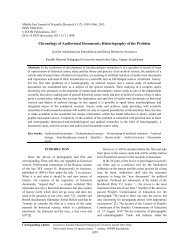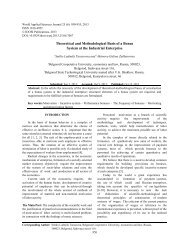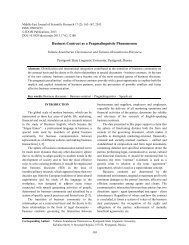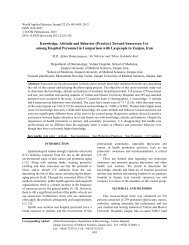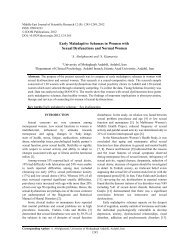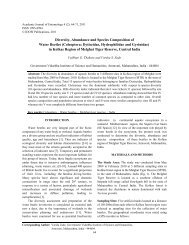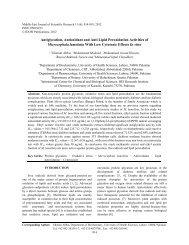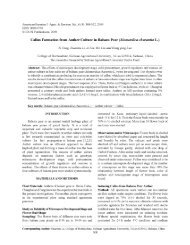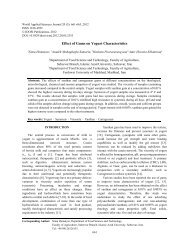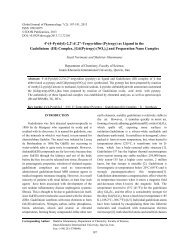Cutaneous Xanthoma in a Domestic Pigeon: Pathologic ... - Idosi.org
Cutaneous Xanthoma in a Domestic Pigeon: Pathologic ... - Idosi.org
Cutaneous Xanthoma in a Domestic Pigeon: Pathologic ... - Idosi.org
You also want an ePaper? Increase the reach of your titles
YUMPU automatically turns print PDFs into web optimized ePapers that Google loves.
Global Veter<strong>in</strong>aria, 10 (2): 140-143, 2013<br />
electro-surgical unit. Oral consumption of oxytetracycl<strong>in</strong>e<br />
<strong>in</strong> dr<strong>in</strong>k<strong>in</strong>g water has been recommended for one week as<br />
a postoperative medication. The bird was discharged on<br />
day 14, when the wound was acceptably dim<strong>in</strong>ished <strong>in</strong><br />
size.<br />
For histopathological evaluation, the removed nodule<br />
by surgical excision was fixed <strong>in</strong> 10% buffered formal<strong>in</strong>.<br />
Embedded paraff<strong>in</strong> tissues were processed by us<strong>in</strong>g<br />
standard procedures. Sections <strong>in</strong> 5-µm thickness were<br />
sta<strong>in</strong>ed with hematoxyl<strong>in</strong>-eos<strong>in</strong> and exam<strong>in</strong>ed<br />
microscopically. Histopathological exam<strong>in</strong>ation revealed<br />
Fig. 1: <strong>Xanthoma</strong> <strong>in</strong> a pigeon. A yellow, sever <strong>in</strong>filtration of numerous, large, foamy macrophages<br />
semi-pedunculated nodule with multiple f<strong>in</strong>e (conta<strong>in</strong><strong>in</strong>g clear vacuoles <strong>in</strong> cytoplasm) with an eccentric<br />
ulcerations on its surface is visible <strong>in</strong> the nucleus as well as vary<strong>in</strong>g degrees of lymphocytes,<br />
featherless part of the w<strong>in</strong>g<br />
eos<strong>in</strong>ophils and mult<strong>in</strong>ucleated giant cells <strong>in</strong> the<br />
superficial and deep dermis. Free lipid-droplets <strong>in</strong> variable<br />
sizes were observed <strong>in</strong> lymphocytes and plasma cells.<br />
A large number of extracellular acicular cholesterol clefts<br />
were present <strong>in</strong> the lesion and some of them were<br />
visible <strong>in</strong> the cytoplasm of giant cells (Fig. 2 and 3).<br />
In some area, mild to moderate acanthosis and<br />
hyperkeratosis was observed. Multifocal necrosis and<br />
ulceration was observed at the superficial epidermis.<br />
The heterophils were <strong>in</strong>filtrated more near the ulcerated<br />
areas. The hemorrhage and necrosis were of the observed<br />
f<strong>in</strong>d<strong>in</strong>gs. On the basis of the histopathologic f<strong>in</strong>d<strong>in</strong>gs,<br />
diagnosis of cutaneous xanthoma was made.<br />
Fig. 2: Histopathologic section of xanthoma reveals<br />
numerous, large, foamy macrophages with an<br />
eccentric nucleus (arrows), lake of free lipid<br />
aggregation (asterisk) and extracellular needle-like<br />
cholesterol clefts (arrowhead) (H-&E, × 100)<br />
Fig. 3: A large number of extracellular cholesterol clefts<br />
(arrowheads) that some of them are visible as<br />
<strong>in</strong>tracellular <strong>in</strong> giant cells cytoplasm (arrow)<br />
(H-&E, × 400)<br />
DISCUSSION<br />
<strong>Xanthoma</strong>s are nodular <strong>in</strong>flammatory lesions that<br />
imitate neoplasms with lipomatous orig<strong>in</strong>. These lesions<br />
can be solitary or multiple and appear as papillary nodules<br />
to raised plaques. Every tissues or <strong>org</strong>ans such as<br />
subcutaneous, tendons, digestive system, kidney and<br />
conjunctiva <strong>in</strong> humans and animals may be affected by<br />
xanthoma [11, 12]. These lesions are not neoplastic but<br />
can <strong>in</strong>vade locally. <strong>Xanthoma</strong>s characterize by<br />
accumulation of lipid-laden macrophages, mult<strong>in</strong>ucleated<br />
giant cells and cholesterol clefts [14-16].<br />
The pathogenesis of xanthomas is not clearly<br />
understood. Disorders <strong>in</strong> lipid metabolism are presumed<br />
<strong>in</strong> the formation of xanthomas. Serum cholesterol or<br />
other lipids are often evaluated <strong>in</strong> affected cases [17, 18].<br />
In human, xanthomas are usually diagnosed as familiarly<br />
and <strong>in</strong> response to secondary hyperlipidemia <strong>in</strong> patients<br />
associated with diabetes mellitus, hypothyroidism,<br />
multiple myeloma, or cholestatic liver disease [19-21]. In<br />
animals affected to xanthomas different types of lipid<br />
components is frequently measured. Abnoemalities <strong>in</strong><br />
141



